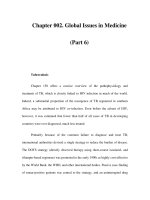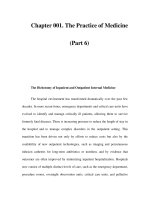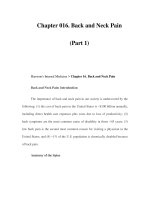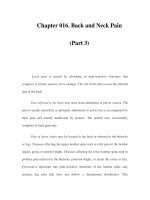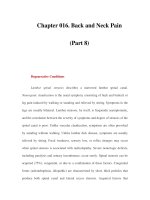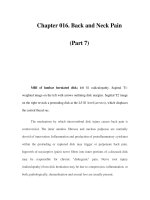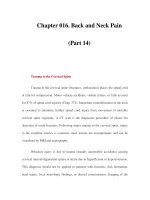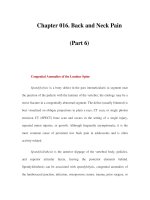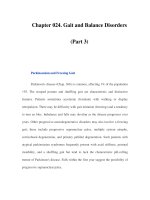Chapter 024. Gait and Balance Disorders (Part 6) ppsx
Bạn đang xem bản rút gọn của tài liệu. Xem và tải ngay bản đầy đủ của tài liệu tại đây (478.9 KB, 5 trang )
Chapter 024. Gait and Balance Disorders
(Part 6)
Toppling Falls
Some patients maintain tone in antigravity muscles but fall over like a tree
trunk, as if postural defenses had disengaged. There may be a consistent direction
to such falls. The patient with cerebellar pathology may lean and topple over
toward the side of the lesion. Patients with lesions of the vestibular system or its
central pathways may experience lateral pulsion and toppling falls. Patients with
progressive supranuclear palsy often fall over backwards. Falls of this nature occur
in patients with advanced Parkinson's disease once postural instability has
developed.
Gait Freezing
Another fall pattern in Parkinson's disease and related disorders is the fall
due to freezing of gait. The feet stick to the floor and the center of mass keeps
moving, resulting in a disequilibrium from which the patient cannot recover. This
can result in a forward fall. Gait freezing can also occur as the patient attempts to
turn and change direction. Similarly, the patient with Parkinson's disease and
festinating gait may find his feet unable to keep up, resulting in a forward fall.
Falls Related to Sensory Deficit
Patients with somatosensory, visual, or vestibular deficits are prone to falls.
These patients have particular difficulty dealing with poor illumination or walking
on uneven ground. These patients often express subjective imbalance,
apprehension, and fear of falling. Deficits in joint position and vibration sense are
apparent on physical examination.
Interventions to Reduce the Risk of Falls and Injury: Treatment
Efforts should be made to define the etiology of the gait disorder and
mechanism of the falls. Standing blood pressure should be recorded. Specific
treatment may be possible, once a diagnosis is established. Therapeutic
intervention is often recommended for older patients at substantial risk for falls,
even if no neurologic disease is identified. A home visit to look for environmental
hazards can be helpful. A variety of modifications may be recommended to
improve safety, including improved lighting and the installation of grab bars and
nonslip surfaces.
Rehabilitation interventions attempt to improve muscle strength and
balance stability and to make the patient more resistant to injury. High-intensity
resistance strength training with weights and machines is useful to improve muscle
mass, even in frail older patients. Improvements are realized in posture and gait,
which should translate to reduced risk of falls and injury. The goal of sensory
balance training is to improve balance stability. Measurable gains can be achieved
in a few weeks of training, and benefits can be maintained over 6 months by a 10-
to 20-min home exercise program. This strategy is particularly successful in
patients with vestibular and somatosensory balance disorders. The Yale Health
and Aging study used a strategy of targeted, multiple risk factor abatement to
reduce falls in the elderly. Prescription medications were adjusted, and home-
based exercise programs were tailored to the patient's need, based on an initial
geriatric assessment. The program realized a 44% reduction in falls, compared
with a control group of patients who had periodic social visits.
Further Readings
Bronstein A et al: Clinical Disorders of Balance, Posture and Gait.
London, Arnold Press, 2003
Ganz DA et al: Will my patient fall? JAMA 297:77, 2007 [PMID:
17200478]
Masdeu J et al: Gait Disorders of Aging: With Special Reference to Falls.
Boston, Little Brown, 1995
Snijders AHet al: Neurological gait disorders in elderly people: Clinical
approach and classification. Lancet Neurol 6:63, 2007 [PMID: 17166803]
Springer S et al: Dual-tasking effects on gait variability: The role of aging,
falls, and executive function. Mov Disord 21:950, 2006 [PMID: 16541455]
Sudarsky L: Gait disorders in the elderly. N Engl J Med 322:1441, 1990
[PMID: 2184358]
Tinetti ME: Preventing falls in elderly persons. N Engl J Med 348:42, 2003
[PMID: 12510042]
